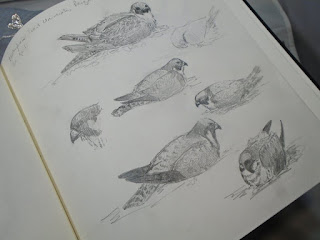April this year has undoubtedly been a tough time for many, with serious restrictions on movement. Stay home is the message. But of course the rhythms of nature continue, and I can truly appreciate how lucky I am, with a garden and plenty of rural footpaths and bridleways to enjoy in a socially distanced manner. So this month's nature journalling has bee done entirely at home, with records of things encountered while out walking or running, or seen from the house and garden.
The start of the month saw a sad pile of feathers on the lawn near the bird feeders - a sure sign of a sparrowhawk in action. It did give me the opportunity to draw and identify them - I think the victim was a chaffinch.
A really useful resource I've found online for feather ID is Featherbase. It has comprehensive photos of feathers from a wide range of birds; indeed, it describes itself as 'biggest and most comprehensive online feather library in the world', and is a fantastic and highly acccessible non-profit-making project.
The weather, certainly for the first part of the month, was fantastically good - blue sky and warm sunshine. My daily outdoor excursions for exercise were either walks or runs, and with the onset of Spring there's always lots to see. Corn buntings, skylarks, a red kite, butterflies and a watchful hare were all about, and the fieldfares that I'd seen on the bare fields a week earlier had gone, back to their breeding grounds in Scandinavia.
The first fledglings in the garden this year were collared doves (though it's entirely possible that the woodpigeons beat them to it and I hadn't noticed!). This pair of youngsters were perched all day in the rowan tree, occasionally being visited and fed by a parent. The leaves weren't yet out and the youngsters looked quite exposed, but they survived and within a few days the foliage was providing good cover.
Easter Sunday was another warm and sunny day, much more like summer than spring. Spent most of the day in the garden, and happily spotted my first house martins of the year.
Out for a run around the fields a few days later, it was still warm and sunny, and I saw my first swallow of the year, skimming low over the green field of cereal. And, extra special, I found a wheatear - a summer migrant, most likely on its way north to its breeding grounds, which tend to be uplands and moors and the like. Even better, a few days later I went for a walk up to the same spot and there were three wheatears - that's definitely the most I've seen together!
The weather finally reverted to the normal spring showers, and then got quite chilly once again. I decided to explore what is available online in terms of nestcams, and have found a great webcam on a peregrine nest, run by the Nottinghamshire Wildlife Trust and Nottingham Trent University. So, it'll be falcon sketching every day for me for the foreseeable future!









